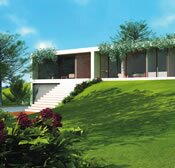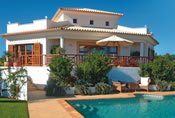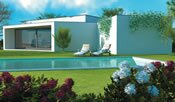Inflight Magazine of Brussels Airlines
Welcome to the Inflight Magazine of Brussels Airlines
21st-centuty living
Laura Henderson visits Portugal and Spain, where leading developers are turning greener attitudes into greater choice
 Sustainable living is no longer the preserve of the cheesecloth-and-sandals brigade. In fact, it has never had more current affairs cachet; from world leaders grandstanding over targets for carbon-monoxide emissions, to high-street retailers pedalling the latest eco-friendly products. “The property market is no different,” says Simon Ducker, managing director of Jones Nash Eco Homes. “These days, buyers are much more in tune with environmental issues, as are agents and developers who are trying to keep abreast of carbon footprint guidelines.”
Sustainable living is no longer the preserve of the cheesecloth-and-sandals brigade. In fact, it has never had more current affairs cachet; from world leaders grandstanding over targets for carbon-monoxide emissions, to high-street retailers pedalling the latest eco-friendly products. “The property market is no different,” says Simon Ducker, managing director of Jones Nash Eco Homes. “These days, buyers are much more in tune with environmental issues, as are agents and developers who are trying to keep abreast of carbon footprint guidelines.”
New laws in Spain, requiring solar panel hot-water systems to be fitted as standard in new-build homes from January 2007, are just the tip of the iceberg. “Solar power is the currency of the future,” says Marisa Dobner of Homesearch Barcelona. “Barcelona City Council has started to prescribe and promote the use of solar energy and, in the long-term, wants to satisfy a good percentage of its energy demand with renewables. Stewardship of local and natural cultural heritage is also a key consideration, as is keeping a handle on water consumption.”
Managing a growing portfolio of bespoke-build projects for European clients across Spain, Jones Nash Eco Homes is riding the wave of an early boom. “Timber-framed houses, a prefabricated method of construction, sell well,” says Ducker. “They’re ‘breathable’, which means moisture can pass through the skin of the building causing no condensation. We also use lime plaster internal finishes, with the option of ‘glaster’ – a texture made from recycled glass added to the plaster – and tube solar panels for domestic hot-water supplies and swimming pools.” Buyers keen on an eco pad can expect to shell out around €100,000 for a three-bedroom detached model.
In southern Alicante, a quiet phenomenon in the rural environs of Calaspara is attracting its share of media interest. Just 40 minutes’ drive from Murcia airport, properties in the Las Torrentas development have been fitted with geothermal pumps. These use heat from the ground to warm houses in winter and keep them cool in summer – warmth discharged from the house is fed back into the ground.
 “The technology has been around for many years,” says Tony Sparks of AGS Properties, “but it’s one of the first systems to be used on a large scale in rural Spain.” Prices start at €248,000 for a three-bedroom townhouse, rising to €336,000 for a three-bedroom villa with a 700sqm plot.
“The technology has been around for many years,” says Tony Sparks of AGS Properties, “but it’s one of the first systems to be used on a large scale in rural Spain.” Prices start at €248,000 for a three-bedroom townhouse, rising to €336,000 for a three-bedroom villa with a 700sqm plot.
Investors at the Monte Mayor resort in Malaga who choose a custom-build property through Carrington Esates can opt for an eco-retainer ‘foundation’ wall. “This is made of layers of compacted earth rather than concrete, held together in a nylon framework,” says Peter Wilkey from project consultants Johnson & Wilkey. “A built-in irrigation system also drip-feeds into the natural vegetation, which grows at its own pace.” A four-bedroom detached villa on a 2,500sqm plot, with double-glazing and wall insulation, costs around €1.1m.
Over-development in certain regions of Portugal, meanwhile, has led to a tightening of planning regulations as
local authorities clamp down on ‘non-compliant’ construction. Renowned for its blue-flag beaches, the Costa Azul south of Lisbon has a reputation for keeping urban sprawl in check in a bid to prevent coastal erosion and protect indigenous wildlife species. Ground was broken in early 2006 on Mata de Sesimbra, the first in a new breed of sustainable resorts with an integrated tourism, nature conservation and reforestation focus. The first phase should be completed early this year. “Mass-market tourism has fuelled demand for sustainable alternatives,” says Paulo Reis-Silva, head of planning for the project’s developers Pelicano. On the surface, the resort will look like any other. Behind the scenes, however, significant differences in the 500-hectare tourism component will set the project apart.
“Mass-market tourism has fuelled demand for sustainable alternatives,” says Paulo Reis-Silva, head of planning for the project’s developers Pelicano. On the surface, the resort will look like any other. Behind the scenes, however, significant differences in the 500-hectare tourism component will set the project apart.
“The area already suffers from serious forest degradation and is prone to fires, so we’re also consulting with local environmental groups and the WWF to create closed-off protected areas for vulnerable nesting birds, recovering wetland and coastal habitats,” says Reis-Silva. Renewable energy will be used, and there will be a sustainable transport network with car pools, an eco-shuttle and cycle routes covering the site. “Rainwater collection and water recycling systems will also achieve huge cuts in domestic water consumption and irrigation,” Reis-Silva adds. Units comprising apartments, townhouses and villas are expected to start in the region of €200,000.
bedroom semi-detached townhouses costing from €320,000, to three- and four-bedroom detached villas for around €700,000.
“An alarming amount of carbon dioxide is belted out by air-conditioning units,” says Jes Mainwaring, director of architecture at the resort. “The Coolhouse system we’re using is an energy-efficient alternative. In summer, warm external air is piped through tubes, significantly reducing internal temperature; in winter, the fresh air is warmed through the system, saving on heating bills.”
Further north, less than an hour’s drive from the Portuguese capital, Lisbon, lies Costa da Prata, a 200km stretch of coast from Ericeira to Espinho, which is flanked by some of the country’s richest protected fishing banks. Near the tourist capital Obidos, leading architects Eduardo Souto
Moura, Alvaro Siza Vieira and David Chipperfield are just three of a team of 14 ‘modernists’ hand-picked by developers Acordo to design a limited-edition collection of villas and townhouses on the Bom Sucesso resort.
“The ethos of the community is inextricably linked with a commitment to habitat conservation,” says Goncalo Castelo Branco, the resort’s executive director. Design features include cantilevered walls, vast expanses of glass and inner courtyards to “bring the outside in”. Each property will also sport a self-irrigating verdant (jasmine-covered) roof, in keeping with the resort’s natural surrounds, which includes a 50-acre eco-reserve.
The resort’s designer credentials have been compared to the Weissenhof Estate in Stuttgart, made famous in the 1930s by Le Corbusier and Mies Van der Rohe. “It’s a flattering association,” says Branco, “but we’re more concerned with environmental integration, blending landscape and features, such as flat roofs, to conserve energy.”
Key in the door
Contact these property agents to find out more about eco properties in Spain and Portugal
Alma Verde www.almaverde.com
AGS Properties www.agsproperties.com
Carrington Estates www.carrington-estates.com
Jones and Nash www.jones-nash.co.uk
Pelicano www.pelicano-sa.pt
Johnson and Wilkey www.johnsonwilkey.com
Homesearch Barcelona www.homesearchbarcelona.com
NL »Woonfilosofie in de 21e eeuw
Laura Henderson bezocht Spanje en Portugal, waar toonaangevende ontwikkelaars steeds groenere projecten opzetten.
Duurzaam bouwen was nog nooit zo trendy als vandaag. “Het massatoerisme leidde tot een grotere vraag naar duurzame alternatieven”, zegt Paolo Reis-Silva van de Portugese projectontwikkelaar Pelicano.
Nieuwe Spaanse wetten die verplichten tot warmwatersystemen met zonnepanelen zijn nog maar het begin. “Zonne-energie wordt hét gat in de markt”, verzekert ons vast-goedspecialiste Marisa Dobner uit Barcelona.
In het zuidelijke Alicante, op 40 minuten rijden van de luchthaven van Murcia, zijn de woningen van het Las Torrentas-project uitgerust met warmtepompen. Deze benutten de warmte uit de bodem om de huizen in de winter te verwarmen, en in de zomer te koelen. Prijzen vanaf €248.000.
Overbebouwing in bepaalde delen van Portugal leidde tot een strengere wetgeving. Daarom kwam men begin 2006 in Mata de Sesimbra aan de Costa Azul ten zuiden van Lissabon met een baanbrekend concept: het eerste in een reeks van duurzame vakantiedorpen die toerisme, natuurbehoud en herbebossing combine-ren. De afronding van de eerste fase is verwacht voor begin dit jaar.
Alma Verde in de Algarve, op 50 minuten van de luchthaven van Faro, is een gelijkaardig project. Daar brengt het Coolhouse-systeem een energiebesparend alternatief voor airconditioning.
Meer naar het noorden ligt de Costa da Prata, vlakbij een van Portugals rijkste, beschermde visgronden. Hier koos men 14 moderne ontwerpers voor de creatie van een woonwijk die de natuurlijke omgeving respecteert. Dat resulteerde in vrijdragende muren, grote glaspartijen, open binnentuinen, daken met irrigatie én een ecogebied van 20 hectare.
Leave a Reply
